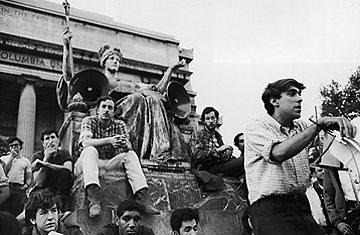
American activist Mark Rudd at Columbia University in 1968
SDS is back, and it has a whole new set of rules. Students for a Democratic Society was once a successful New Left organization in the 1960s until it turned radical. During a 1968 strike at Columbia University, bands of SDSers took the Dean of Students hostage, and another faction later developed into the Weathermen, a militant underground group best remembered for their penchant for bombs.
Now a new group using the SDS name has emerged, one with a penchant for participatory democracy but also with some fairly big logistical challenges. Inaugurated in January 2006, the new SDS has been gaining slow but steady speed ever since, with chapters springing up at colleges across the U.S., including Kent State University, Boston College and UCLA. According to the group's wiki site, there are 148 university chapters, along with 50 high school branches and a number of regional movements. But the numbers are misleading. While many chapters dot the country, individual schools may have only a handful of active members.
On July 27 in Detroit, the group held its second national convention, where it set out guidelines and a complex organizational hierarchy. The new SDSers opted for a horizontal structure with a national council made up of a single delegate from each chapter who will help facilitate decisions made on the local level. Another structure made up of a handful of different working groups will help decide everything from the specifics of next year's convention to coordinating action.
And since the new SDS says it's all about local action, individual chapters will determine the course of the group as a whole. Various national interest groups (not to be confused with the previously mentioned working groups) — including different caucuses for women, people of color and queer people — keep everyone in check. "This is of the utmost importance if SDS is to remain effective," says Dave Schulka, a UCLA SDSer. "SDS is an anti-oppression organization."
Spokespeople who fielded questions about the convention were also elected in Detroit and had to meet certain criteria. They had to be female because "men dominate SDS media so now only women will be SDS spokespeople," explains Schulka, a male, and "half or more of the group should be of color or queer." While anyone can be interviewed, Schulka explains, SDSers are eventually supposed to refer media inquires back to this all-female enclave.
If this all sounds confusing, it's because they are confused. Schulka says to think of the group's executive organization as a bunch of little pebbles. "Draw a circle around all these pebbles," he says, and they all kind of connect.
But some argue that this organization has just simply hijacked the old SDS name. "SDS in the 1960s was real; SDS in 2007 is a fraud," says Maurice Isserman, a professor of history at Hamilton College and a former SDSer at Reed College.
As early as 1965, SDS was organizing national anti-war demonstrations that attracted over 20,000 participants, and a national office with a regular newspaper kept individual chapters connected. Critics now are quick to point out that this time, SDS is basically an Internet group with limited face-to-face interaction, which was so crucial to the original.
"'SDS' today is a virtual organization, utterly dependent on the web, with no national office, no newspaper, unable to muster more than a few score followers at other people's demonstrations, controlled by a small clique of non-student 'elders,' and hollow at the center," Isserman points out.
The new SDSers do more than dwell on the war or civil rights issues: they are big on institutional change and blaming the same forces their '60s counterparts were fighting. But if the rhetoric slung by current SDSers is any indication, the group's goals are ambitious. SDSers seem keen to point out problems with "the system," and their collective agenda is to tackle a host of anti-imperialist issues including the war in Iraq and concerns about the global economy, immigration and racism. SDS isn't just focusing on the U.S. "The military industrial complex is huge, of course," says Marisa Holmes, a School of the Art Institute of Chicago chapter member.
Second-generation SDSers argue that they will not make the same mistakes as their forebears by veering towards the extreme Left. The Weathermen's actions have nothing to do with the group's current ambitions, they say, and they are sick of cynics drawing comparisons. Still, the new SDS will have to grapple with its unsavory past, while looking to carve out an activist niche of its own.
Some wonder why they chose the controversial label in the first place. Why not start a fresh organization? According to many current members, the SDS name packs major punch. "Part of the attraction for revising SDS was its history, its legacy and its promise," says Schulka. "In the '60s it had real promise. Today it has real promise."
As students start to head back to campus, the decisions made at the Detroit convention will be put to the test. SDSers may still have time to prove themselves. "SDS is just beginning to organize itself. They're learning from our mistakes, not repeating them," says Mark Rudd, the leader of the 1968 Columbia strike who has been an unofficial consultant to the new SDS. "Give it time before you make comparisons."
